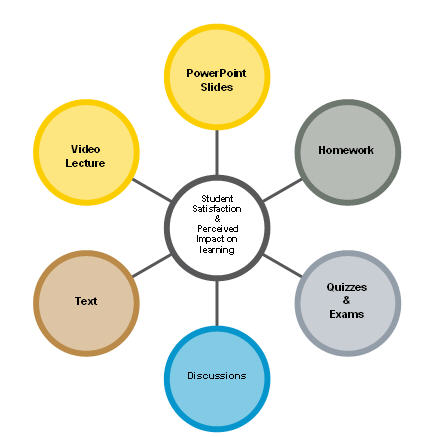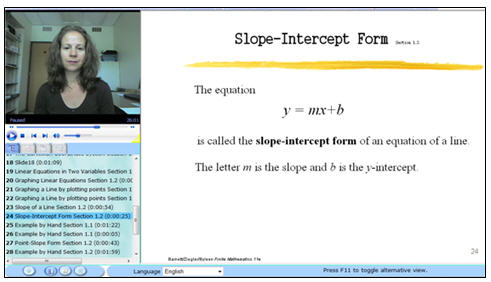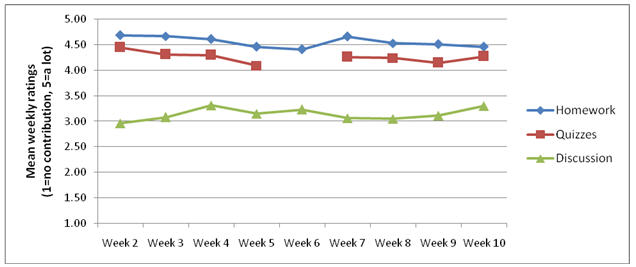Figure 7. Contribution of Active LOs to Perceived
Learning.
The active LOs, on the other hand, are stable
throughout the 10 weeks of the course. Homework was
consistently reported to have the greatest
contribution to the learning, quizzes were also said
to have had an impact on learning and, according to
the students, Blackboard discussions consistently
contributed less to their learning of the material. As previously noted, these active LOs also
correspond to the required components of the
course.
Although the students were given opportunities
throughout the quarter to rate the contribution of
each LO to their learning, they were asked to do so
again on the final survey. The question on the
final survey asked them to reflect globally on the
contribution of each LO to their overall learning of
the course material. The mean overall ratings are
in Table 6.
The
students reported that the homework assignments
contributed the most to their overall learning of
the material. This is consistent with responses
from the weekly surveys where homework was reported
to be the LO having the greatest contribution to
learning every week.
Table 6. Contribution of LOs to Overall Learning
|
Learning Object
|
N
|
Mean
(1=not at all, 5=a lot) |
SD
|
|
Homework |
45 |
4.71 |
.66 |
|
Quizzes |
45 |
4.31 |
1.02 |
|
PowerPoint slides |
45 |
4.02 |
1.25 |
|
Lectures |
45 |
3.91 |
1.46 |
|
Text |
45 |
3.33 |
1.38 |
|
Blackboard discussions |
45 |
3.02 |
1.37 |
To validate the rating data, students were
presented with five LOs (quizzes were not included
in this ranking question) and asked to rank them
based on which they believed had the greatest
overall impact on them; the results of those
rankings are in Table 7. In this ranking exercise,
it was impossible to assign the same rank to more
than one item; therefore, students who might have
rated, homework and lectures, for example, as both
having a lot of impact on their learning were forced
to choose which had the most impact, which
had the second most impact, and so on. As with the
quality and learning contribution ratings previously
presented, homework emerged as the most important
LO, ranking #1.
Without this impact ranking data, one might conclude that the
required LOs would always come out “on top” of the
pile in terms of impact on learning; however, note
that this is not the case. Homework came out on top
for usage and impact on learning, but the 2nd,
3rd, and 4th LOs (lectures,
PowerPoint and text) ranked in terms of overall
impact were not required LOs and did not rank high
in terms of usage (see Figure 4). This is
additional evidence of the importance and value of
the homework support provided by the CC/MML site.
Table 7. Impact on learning of LOs—Overall
Rankings
|
LO
|
Rank
|
|
Homework |
1st |
|
|
Lectures |
2nd |
|
|
PowerPoint slides |
3rd |
|
|
Text |
4th |
|
|
Blackboard discussions |
5th |
|
Quality.
In the final survey of the quarter, students were
asked to rate the quality of each of the LOs. Table
8 presents the mean ratings (on a 1-to-4 point
scale) of each LO. Homework, the LO that students
consistently used the most, and that they felt
contributed the most to their learning, was rated
highest quality; the text, which was used
moderately, received the lowest rating.
Table 8. Overall Quality Ratings of LOs
|
LO
|
N
|
Mean
(1=poor, 4=excellent) |
SD
|
|
Homework |
45 |
3.58 |
.54 |
|
Quizzes |
45 |
3.22 |
.67 |
|
PowerPoint slides |
45 |
3.11 |
.91 |
|
Lectures |
45 |
3.02 |
.81 |
|
Blackboard discussions |
44 |
2.59 |
.84 |
|
Text |
45 |
2.58 |
.92 |
Satisfaction.
Two
measures were used to determine overall student
satisfaction with this online course: a
standardized question on the general student course
evaluation form distributed to all students at the
end of every class and a question on the final
online survey of the quarter that asked students
whether they would recommend this particular online
course. Table 9 shows the frequencies of responses
to both items: 58 students completed the course
evaluation administered by the University; of those,
86.2% said that the course was outstanding or good.
About the same percentage of students who answered
the recommend question on the final course survey
(86.7%) said that they would recommend the course.
Together, these two questions provide compelling
evidence to support the claim that students in this
online course were overwhelmingly satisfied.
Table 9. Overall Rating and Likelihood to Recommend
|
Evaluation item |
Frequency (percent) |
|
Overall course rating
Outstanding
Good
Fair
Poor |
26 (44.8%)
24 (41.4%)
5 (8.6%)
3 (5.2%) |
|
Would recommend the course
Yes
No |
39 (86.7%)
6 (13.3%) |
Discussion
Because of the challenges of notation and intricacy
of content, mathematics is one of the most
challenging disciplines to offer online. However,
the availability of rich, publisher-supported online
homework sites such as CC/MML and software such as
Acustudio has made the creation of LOs for teaching
mathematics relatively easy. Acustudio makes
possible the creation of rich online lectures that,
in the past, would have required extensive
instructional technology design support. The
ability to show hand-worked examples using the
“whiteboard” feature was key to the successful
implementation of this software. Students reported
that the “examples by hand” created utilizing the
whiteboard were an especially useful component of
the lectures. However, far and away the most highly
utilized and consistently preferred LO was the
homework. As shown in the screenshot in Figure 3,
the CC/MML site offers a variety of tools for
students completing homework assignments. Students
are able to view examples, request help solving a
problem and link directly to relevant pages in the
e-text. In addition, students are given immediate
feedback on their solutions. This instant feedback
speaks also to student preferences as described by
Swan (2003). If an incorrect solution is entered,
students are able to solve a similar problem
(generated by MML) for credit. This rewards
persistence and helps students become familiar with
procedures and patterns found in solving certain
types of problems. CC/MML allows students to
interact with the material in a manner that
exemplifies the notion of active learning. There
is evidence (Bonwell & Eison, 1991; Sahin, 2007)
that active participation in content leads to
greater and longer lasting understanding of
material. Thus, in this online environment, the
fact that students engaged with, perceived the
values of, and spent a majority of their time doing
homework is a positive outcome in terms of student
learning online. It would be interesting to
compare student performance and preferences to that
of a face-to-face class with the same credit
structure that offers all the mentioned support
mechanisms (including videos) and regular (in terms
of time as well as delivery mode) class meetings. This is an area of great interest and may be pursued
for verification in future studies.
Another area of interest is the lack of value that
students placed on the discussion portion of the
class. There were, in fact, two aspects of the
discussion: a required component and an optional
component. The students were only asked to comment
on the required component, which consisted of
students responding to an instructor “prompt” (a
question, problem or statement). The 60 points
total for discussion participation were distributed
as follows: 3 responses (chosen by the student)
were graded for quality (content and communication
skills) by the instructor for a total of 30 points
(10 points each). The remaining 30 points were
given based upon timely and consistent responses to
the prompts throughout the quarter. The prompts
were designed to encourage students to think more
deeply about the material and its applications.
Some sample prompts are: “We know that two points
determine a unique line. What if you have 3
points? How many distinct lines pass through at
least 2 of the given points? Is the answer always
the same? How do the various transformations
(shifts, stretches and shrinks) affect the equation
of a line and the graph of that line (think about
the slope and y-intercept)?” and “Find two examples
in the newspaper or online of automobile loan offers
that require periodic payments and compare the
offers.” Thus we see that “discussion” is somewhat
of a misnomer for this portion of the course that
does not fit the traditional definition of
“discussion.” Students were encouraged to respond
to each other’s postings but did not often do so.
On the other hand, there were optional discussion
boards where students could post questions and
comments about the course. Because open discussion
boards had only optional participation, it was not
included in the weekly survey questions. However,
in the final survey, “Instructor responses to your
discussion postings” was among the course components
rated for quality and contribution to overall
learning. It is of note that for this final survey,
the optional and required discussion boards were not
distinguished. In terms of quality, these
instructor responses were rated 2nd only
to the homework with a mean score of 3.25 (1 = poor,
4 = excellent, SD = .78) while the Blackboard
discussions had a rating of 2.59 (SD = .84). In
terms of contribution to overall learning,
Instructor responses were rated 5th (out
of 7) for a mean of 3.64 (with 1 = not at all, 5 = a
lot, SD = 1.46) while the Blackboard discussions
ranked last overall with a mean score of 3.02 (SD =
1.37).
Features of a face-to-face class that were lost in
this online course were useful office hour
interactions between student and faculty and partial
credit on students’ solutions. While office hours
were offered both online and face-to-face, students
rarely took advantage of this availability. The
online office hours were offered in chat format,
limiting the ability to use the required notation
for useful interaction, and students generally could
not travel to campus to attend face-to-face office
hours. It is certainly a difficult mode of
communication for mathematics. However, students
did interact with the instructor and each other on
discussion boards. A potential solution to this
problem is offered by a very promising communication
software package titled enVision. This software
allows for anonymous online communication between
students and faculty with rich notational
availability. One study (Hooper, et. al., 2006)
reports that enVision sessions are more effective
than traditional office hours. The software
(freeware) allows any number of students to “attend”
an online office hour and participate, or lurk, as
they choose. Several strengths of the software are
described as “Anonymity”, “Engagement and multi-way
dialog” and “Passive participation.” Incorporation
of enVision into future offerings of the course here
are being considered.
Students’ open-ended comments about their online
learning experience revealed that there was a great
deal of disappointment over the lack of partial
credit in the online homework. This will be
addressed in future offerings of the course by
requiring the final exam to be a traditional “paper
and pencil” exam, graded by the instructor. There
is also impressive work being done on creating and
incorporating partial credit in computer-aided
homework grading (Ahton, et. al., 2006) and (Livne,
et. al., 2007). If these processes were to come to
fruition, it would greatly enhance the online
homework services currently offered.
Conclusions
The
preference, satisfaction, and perceived impact on
learning reported by students in this online class
are encouraging for students and instructors of
online mathematics courses. Students clearly felt
that the course was demanding though time
consuming. A large majority of the students rated
the class as good or outstanding (50 out of 58) and
an even greater majority found the class to be
intellectually challenging (54 out of 58). This
demonstrates that the course, while requiring a lot
of work, was perceived as successful by most
students. The strong preference for the active
learning LO homework coupled with the perceived
impact on learning of the lectures lead to the
overall impression that the online environment
offered these students an extensive, flexible and
rich learning experience. While there are some
areas of concern, the rate at which tools for
instruction online are being developed leads the
authors to believe that many will be addressed in
due time. The findings in this paper point to a
best practices model for online mathematics that
strongly utilizes practice problems with fast
feedback and integrates tools for content delivery
such as media-enhanced lectures. This combination
of LOs will provide students with the tools that
they need to succeed online.
Acknowledgements
Both authors are grateful for funding from the
Faculty Support Grants Program at CSUEB. The first
author also thanks the members of the FLC for Best
Practices in Online Teaching and Learning and the
members of the FLC for the Scholarship of Teaching
and Learning. The authors appreciated the
reviewers’ comments and have incorporated their
suggestions. We feel this has made a stronger
paper.
References
Ahton, H., Beevers, C., Korabinski, A. & Youngson,
M. (2006) Incorporating partial credit in
computer-aided assessment of Mathematics in
secondary education. British Journal of
Educational Technology, 37(1), 93-119.
Bennett, K. & McGee, P. (2005). Transformative
power of the learning object debate. Open
Learning, 20(1), 15-30.
Bonwell, C. & Eison, J. (1991). Active learning:
Creating excitement in the classroom. ASHEERIC
Higher Education Report No. 1, George Washington
University, Washington, D.C.
Cuthrell, K. & Lyon, A. (2007). Instructional
strategies: What do online students prefer?
MERLOT Journal of Online Learning and Teaching,
3(4), 357-362 (https://jolt.merlot.org/documents/cuthrell.pdf)
Dennen, V. (2008). Pedagogical lurking: Student
engagement in non-posting discussion behavior
Computers in Human Behavior, 24(4), 1624-1633.
Ellis, T. & Cohen, M. (2005). Building the better
asynchronous computer mediated communication system
for use in distributed education. Proceedings of
the 35th Frontiers in Education
Conference (pp T3E15-T3E20).
Piscataway, NJ: IEEE.
Friesen, N. (2003). Three objections to learning
objects. Available online at:
phenom.edu.ualberta.ca/˜nfriesen (accessed May
2008).
Hodgins, W. (2000). Into the future. Available
at:
http://www.learnactivity.com/download/MP7.PDF,
p27.
Hooper, J., Pollanen, M. & Teismann, H. (2006). Effective Online Office Hours in the Mathematical
Sciences. MERLOT Journal of Online Learning and
Teaching, 2(3), 187-194 (https://jolt.merlot.org/vol2no3/hooper.pdf)
Liber, O. (2005). Learning objects: Conditions
for viability. Journal of Computer Assisted
Learning, 21, 366-373.
Livne, N., Livne, O. & Wight, C. (2007). Can
Automated Scoring Surpass Hand Grading of Students’ Constructed Responses and Error Patterns in
Mathematics? MERLOT Journal of Online Learning
and Teaching, 3(3), 295-306 (https://jolt.merlot.org/vol3no3/livne.pdf)
Parish, P. (2004). The trouble with learning
objects. Educational Technology Research and
Development, 52(1), 49-61.
Pelz, B. (2004). Three principles of effective
online pedagogy. JALN 8(3), retrieved May
2008 from
http://www.sloan-c.org/publications/JALN/v8n3/v8n3_pelz.asp
Prince, M. (2004). Does active learning work? A
review of the research.Journal of Engineering
Education, 93(3), 223-231.
Saba, F. (2005). Critical issues in distance
education: A report from the United States.
Distance Education, 26(2), 255-272.
Sahin, I. (2007). Predicting student satisfaction
in distance education and learning environments.
(ERIC Document Reproduction Service No. ED 496541).
Swan, K. (2003). Learning effectiveness: What the
research tells us. In J. Bourne & J. Moore (Eds.) Elements of Quality Online Education, Practice
and Directions. Needham, MA:
Sloan Center
for Online Education, 13-45.
Wiley, D. (2002). Connecting learning objects to
instructional design theory: A definition, a
metaphor, and a taxonomy. In D. Wiley (Ed.) The
Instructional Use of Learning Objects. The
Agency for Instructional Technology,
Bloomington,
IN, 4.
|








